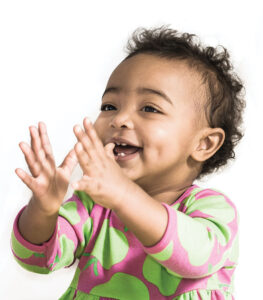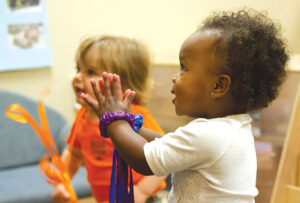Fine motor development
Toddlers participate in a song that includes opportunities to clap and smile.

None


Be Prepared: Place carpet squares in an open area where toys have been put away.
[Invite toddlers to join you to sing and move our hands.]
We are learning to clap while we sing a song.
 Let’s clap our hands together!
Let’s clap our hands together!
[Lead toddlers in clapping. Demonstrate by spreading your arms wide and clapping in front of your body.]
I can hear our clapping!
We have a new song today. Our song says that when we feel happy, we clap our hands.
Let’s show a happy face.
[Offer a big smile as a happy face. Encourage toddlers to smile.]
We smile when we feel happy!
I think we are ready to sing our song. We will clap our hands and show our happy face when we clap.
[Sing “If You’re Happy and You Know It.”]
Yeah for all of us! We are clapping and smiling.
Would you like to sing our clapping song again?
[Pause for responses. Describe toddlers’ reactions. Repeat the song with actions or lead toddlers in a different familiar song.]
We clapped our hands to a song about feeling happy. We showed our happy faces!
Some toddlers will imitate clapping and may begin to sing a few words. Some toddlers will participate by observing and maybe occasional clapping. Some toddlers may show a happy face when invited. At this age, a toddler may clap and/or smile, but probably not both at the same time. Do not encourage or expect toddlers to clap in unison. Positively recognize all types of participation, including a toddler who may listen and watch from across the room.
Extra support
Enrichment
Fine motor development, Gross motor development
Toddlers participate in a song with opportunities to clap their hands slowly and stomp their feet quickly.

None


Invite several toddlers to join you for fun in moving our bodies and singing a song. Encourage toddlers to stand facing you. Explain that we are going to do two things with our bodies. Example: “First we are going to clap slowly.” Encourage toddlers to clap slowly with you. Use wide arm moves to demonstrate clapping. Emphasize slow claps. Example: “Next, we are going to stomp our feet quickly.” Demonstrate stomping your feet in relatively fast movements that toddlers in your group can readily manage. Encourage toddlers to stomp their feet with you.
Explain that you will sing a song that helps us clap our hands slowly and stomp our feet quickly. Sing the following song with the actions. Encourage toddlers to join you with the actions. Repeat if toddlers show interest. (Tune: “Row, Row, Row Your Boat”)
Clap, clap, clap your hands,
[Say words slowly. Clap slowly.]
As slowly as you can.
Stomp, stomp, stomp your feet,
[Say words fast. Stomp quickly.]
As quickly as you can.
This activity involves three different factors (clapping, stomping, speed) for toddlers to consider. The opportunity to clap and stomp is more beneficial than the speed at which toddlers clap or stomp. Anticipate that some toddlers will not focus on the slow and quick requests. Do not encourage or expect toddlers to clap and stomp in unison. Doing actions with a song often helps toddlers relax, but you may wish to say rather than sing the lyrics if it appears the tune is a distraction.
Extra support
Enrichment
Fine motor development, Gross motor development
Toddlers participate in a song that includes opportunities to clap and kick from a sitting position.

None


 Invite toddlers to sit on the floor with you. Sing “If You’re Happy and You Know It” and encourage toddlers to clap their hands with you. Use a pronounced approach to clapping by spreading your arms wide in the clap. Explain to toddlers that clapping and smiling are ways to show we are happy. Example: “We can smile to show we are happy. We can clap when we are happy.”
Invite toddlers to sit on the floor with you. Sing “If You’re Happy and You Know It” and encourage toddlers to clap their hands with you. Use a pronounced approach to clapping by spreading your arms wide in the clap. Explain to toddlers that clapping and smiling are ways to show we are happy. Example: “We can smile to show we are happy. We can clap when we are happy.”
After singing one verse and encouraging toddlers to clap with you, explain that the song also says we can kick our feet to show we are happy. Demonstrate kicking by sitting on the floor with your legs outstretched. Invite toddlers to try kicking their feet. Example: “Let’s put our legs in front of our bodies. Our legs can be straight. We can see our shoes.” If a toddler tries, but does not fully get into the position, offer assistance as appropriate.
Sing the song again with the verse, “kick our feet.” Kick your own feet during the song and invite toddlers to do the same. Repeat the verse and actions if the toddlers enjoy the actions.
If toddlers in your center are familiar with baby sign language, make the sign for the word “happy” and encourage toddlers to imitate the sign. At this age, the toddlers are not expected to use the sign in the song.
This option is somewhat more challenging than Option 2 because the suggested physical movements occur in a sitting position. In particular, kicking while in a sitting position is more difficult than the Option 2 action of stomping while standing.
At any age, it takes practice to produce a new physical movement after seeing it demonstrated. Toddlers are generally eager to try new actions with their bodies, and kicking is a movement most toddlers find enjoyable and fun to repeat. Consider the repeats as practice because it may take time for toddlers to figure out how to kick while in a sitting position. Offer guidance on this process. Example: Toddlers may need to put both hands on the floor for stability when kicking.
As with all activities, toddlers are likely to differ in type and amount of participation. Example: A toddler may eagerly clap with the song but not kick or may try kicking at a later point if the activity is offered again. As always, positively acknowledge all forms of participation.
Extra support
Enrichment
Materials Needed: Clap Your Hands by Lorinda Bryan Cauley, musical instruments, Clap Your Hands by David Ellwand, teddy bears
Share the book Clap Your Hands with interested toddlers and encourage them to clap their hands with you. On another day, place musical instruments on a low table and encourage toddlers to move and make sounds. Clap your hands to show you appreciate the toddlers’ music and movements.
Display the board book Clap Your Hands on a low surface with teddy bears. Talk about the pictures with several toddlers. Use a teddy bear to demonstrate clapping.
Other children in your setting may like to participate in one of the suggested options with toddlers. They may enjoy demonstrating clapping actions, for example, or leading toddlers in clapping. Infants will enjoy the song. As a follow-up activity, ask children what makes them feel happy. Make up sayings or simple song verses based upon the children’s responses, such as playing with a ball. Watch the infants’ reactions to the song and incorporate their actions into the song. Examples: “If you’re happy and you know it, throw the ball.” Imitate throwing a ball.